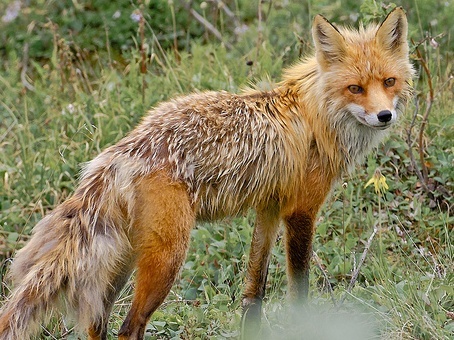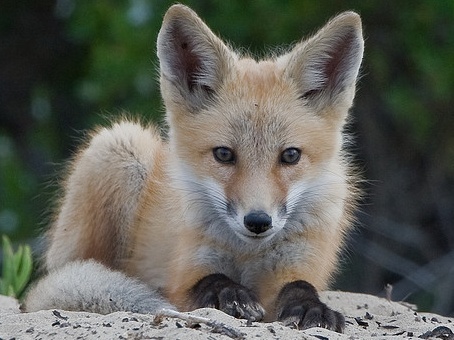RP Weather & Time

|
Time of Day: Light Flurries |
|
|
Season and Month: Winter - Jaunary (WC Territory) |
Year 3 (1972) |
|
Log in
Latest topics
Joining the Pack
Make sure to fill in a joining form on our STP Thread!
Accounts will not be activated until you do so!
Accounts will not be activated until you do so!
Top posting users this week
| No user |
Top posting users this month
| No user |
The Red Fox
Page 1 of 1 • Share
 The Red Fox
The Red Fox
──────────────────────────────────────────────────────────────────────────────────────
The Red Fox
──────────────────────────────────────────────────────────────────────────────────────
Adult

Cub

──────────────────────────────────────────────────────────────────────────────────────
General Information;
Type: Mammal
Diet: Omnivore
Size: Head and body, 18 to 33.75 in (46 to 86 cm); Tail, 12 to 21.75 in (30.5 to 55.5 cm)
Weight: 6.5 to 24 lbs (3 to 11 kg)
Scientific Classification: Kingdom: Animalia, Phylum: Chordata, Class: Mammalia, Order: Carnivora, Family: Canidae, Tribe: Vulpini
Conservation Status:

Size relative to a 6-ft (2-m) man:


# Red Fox Range

The red fox is the largest of the true foxes, as well as being the most geographically spread member of the Carnivora, being distributed across the entire northern hemisphere from the Arctic Circle to North Africa, Central America and the steppes of Asia. Its range has increased alongside human expansion, having been introduced to Australia, where it is considered harmful to native mammal and bird populations. Because of these factors, it is listed as Least Concern for extinction by the IUCN. Red foxes live around the world in many diverse habitats including forests, grasslands, mountains, and deserts. They also adapt well to human environments such as farms, suburban areas, and even large communities. The red fox's resourcefulness has earned it a legendary reputation for intelligence and cunning.
──────────────────────────────────────────────────────────────────────────────────────
Physical Features;
Red foxes have elongated bodies and relatively short limbs. The tail, which is longer than half the body length (70% of head and body length[53]), is long, fluffy and reaches the ground when in a standing position. Their pupils are oval and vertically oriented. The forepaws have five digits, while the hind feet have only four and lack dewclaws. They are very agile, being capable of jumping over 2 metre high fences and swim well. On average, adults measure 35–50 cm (14–20 in) high at the shoulder and 45 to 90 cm (18 to 35 in) in body length with tails measuring 30 to 63 in (760 to 1,600 mm). The ears measure 7.7–12.5 cm (3–5 in) and the hind feet 12–18.5 cm (5–7 in). They weigh 2.2 to 14 kg (4.9 to 31 lb), with vixens typically weighing 15–20% less than males. Adult dog-foxes have skulls measuring 129–167 mm, while those of vixens measure 128–159 mm. The forefoot print measures 60 mm in length and 45 mm in width, while the hind foot print measures 55 mm long and 38 mm wide. They trot at a speed of 6–13 km/h, and have a maximum running speed of 50 km/h. They have a stride of 25–35 cm when walking at a normal pace. The winter fur is dense, soft, silky and relatively long. In northern foxes, the fur is very long, dense and fluffy, but is shorter, sparser and coarser in southern forms. Among northern foxes, the North American varieties generally have the silkiest guard hairs, while most Eurasian red foxes have coarser fur. There are three colour morphs; red, silver/black and cross. In the typical red morph, their coats are generally bright reddish-rusty with yellowish tints. A stripe of weak, diffuse patterns of many brown-reddish-chestnut hairs occurs along the spine. Two additional stripes pass down the shoulder blades which, together with the spinal stripe, form a cross. The lower back is often a mottled silvery colour. The flanks are lighter coloured than the back, while the chin, lower lips, throat and front of the chest are white. The remaining lower surface of the body is dark, brown or reddish.During lactation, the belly fur of vixens may turn brick red. The upper parts of the limbs are rusty-reddish, while the paws are black. The frontal part of the face and upper neck is bright brownish-rusty red, while the upper lips are white. The backs of the ears are black or brownish-reddish, while the inner surface is whitish. The top of the tail is brownish-reddish, but lighter in colour than the back and flanks. The underside of the tail is pale grey with a straw coloured tint. A black spot, the location of the supracaudal gland, is usually present at the base of the tail. The tip of the tail is white.
──────────────────────────────────────────────────────────────────────────────────────
Mental Features;
Red foxes either establish stable home ranges within particular areas or are itinerant with no fixed abode. They use their urine to mark their territories. Urine is also used to mark empty cache sites, as reminders not to waste time investigating them. Red foxes live in family groups sharing a joint territory. Like a cat, the fox's thick tail aids its balance, but it has other uses as well. A fox uses its tail (or "brush") as a warm cover in cold weather and as a signal flag to communicate with other foxes. In favourable habitats and/or areas with low hunting pressure, subordinate foxes may be present in a range. Subordinate foxes may number 1-2, sometimes up to 8 in one territory. These subordinates could be formerly dominant animals, but are mostly young from the previous year, who act as helpers in rearing the breeding vixen's kits. Alternatively, their presence has been explained as being in response to temporary surpluses of food unrelated to assisting reproductive success. Non-breeding vixens will guard, play, groom, provision and retrieve kits, an example of kin selection. Red foxes may leave their families once they reach adulthood if the chances of winning a territory of their own are high. If not, they will stay with their parents, at the cost of postponing their own reproduction
──────────────────────────────────────────────────────────────────────────────────────
Diet;
Red foxes are omnivores with a highly varied diet. They primarily feed on small, mouse-like rodents like voles, mice, ground squirrels, hamsters, gerbils, woodchucks, pocket gophers and deer mice. Secondary prey species include birds (with passeriformes, galliformes and waterfowl predominating), leporids, porcupines, raccoons, opossums, reptiles, insects, other invertebrates and flotsam (marine mammals, fish and echinoderms). On very rare occasions, they may attack young or small ungulates. They typically target mammals up to about 3.5 kg in weight, and require 500 grams of food daily. Red foxes readily eat plant material and in some areas, fruit can amount to 100% of their diet in autumn. Commonly consumed fruits include blueberries, blackberries, raspberries, cherries, persimmons, mulberries, apples, plums, grapes and acorns. Other plant material includes grasses, sedges and tubers. They typically only feed on carrion in the late evening hours and at night. They are extremely possessive of their food, and will defend their catches from even dominant animals. Red foxes seem to dislike the taste of moles, but will nonetheless catch them alive and present them to their kids as playthings.
──────────────────────────────────────────────────────────────────────────────────────
Wolf vs. Red Fox;
Foxes, like coyotes, weasels, and bears, will scavenge off of wolf kills. Many other species also rely somewhat on food gained from wolf kills. These include eagles, gulls, grey jays, blue jays, stellar's jays, red squirrels, deer mice, black-capped chickadees, boreal chickadees, and bobcats. Wolves will sometimes raid food caches that a fox has prepared, and wolves will also take over old fox dens. Wolves often ignore foxes, since foxes do not compete with wolves for food as foxes hunt much smaller animals than wolves do. However, wolves will chase away, and possibly catch, injure and kill, a fox that was caught feeding on its kill. Most foxes are fast and alert enough to get away from the wolves first. Although it is rare, wolves have been known to prey on red foxes.
──────────────────────────────────────────────────────────────────────────────────────
Credits (c);
Images:
http://www.flickr.com/photos/garpete/5993918869/
http://www.flickr.com/photos/mikebaird/2532644595/
Information:
http://en.wikipedia.org/wiki/Red_fox
http://animals.nationalgeographic.com/animals/mammals/red-fox/?source=A-to-Z
http://www.freewebs.com/alphawolfsabrina/wolfecology.htm
──────────────────────────────────────────────────────────────────────────────────────
The Red Fox
──────────────────────────────────────────────────────────────────────────────────────
Adult

Cub

──────────────────────────────────────────────────────────────────────────────────────
General Information;
Type: Mammal
Diet: Omnivore
Size: Head and body, 18 to 33.75 in (46 to 86 cm); Tail, 12 to 21.75 in (30.5 to 55.5 cm)
Weight: 6.5 to 24 lbs (3 to 11 kg)
Scientific Classification: Kingdom: Animalia, Phylum: Chordata, Class: Mammalia, Order: Carnivora, Family: Canidae, Tribe: Vulpini
Conservation Status:

Size relative to a 6-ft (2-m) man:

# Red Fox Range

The red fox is the largest of the true foxes, as well as being the most geographically spread member of the Carnivora, being distributed across the entire northern hemisphere from the Arctic Circle to North Africa, Central America and the steppes of Asia. Its range has increased alongside human expansion, having been introduced to Australia, where it is considered harmful to native mammal and bird populations. Because of these factors, it is listed as Least Concern for extinction by the IUCN. Red foxes live around the world in many diverse habitats including forests, grasslands, mountains, and deserts. They also adapt well to human environments such as farms, suburban areas, and even large communities. The red fox's resourcefulness has earned it a legendary reputation for intelligence and cunning.
──────────────────────────────────────────────────────────────────────────────────────
Physical Features;
Red foxes have elongated bodies and relatively short limbs. The tail, which is longer than half the body length (70% of head and body length[53]), is long, fluffy and reaches the ground when in a standing position. Their pupils are oval and vertically oriented. The forepaws have five digits, while the hind feet have only four and lack dewclaws. They are very agile, being capable of jumping over 2 metre high fences and swim well. On average, adults measure 35–50 cm (14–20 in) high at the shoulder and 45 to 90 cm (18 to 35 in) in body length with tails measuring 30 to 63 in (760 to 1,600 mm). The ears measure 7.7–12.5 cm (3–5 in) and the hind feet 12–18.5 cm (5–7 in). They weigh 2.2 to 14 kg (4.9 to 31 lb), with vixens typically weighing 15–20% less than males. Adult dog-foxes have skulls measuring 129–167 mm, while those of vixens measure 128–159 mm. The forefoot print measures 60 mm in length and 45 mm in width, while the hind foot print measures 55 mm long and 38 mm wide. They trot at a speed of 6–13 km/h, and have a maximum running speed of 50 km/h. They have a stride of 25–35 cm when walking at a normal pace. The winter fur is dense, soft, silky and relatively long. In northern foxes, the fur is very long, dense and fluffy, but is shorter, sparser and coarser in southern forms. Among northern foxes, the North American varieties generally have the silkiest guard hairs, while most Eurasian red foxes have coarser fur. There are three colour morphs; red, silver/black and cross. In the typical red morph, their coats are generally bright reddish-rusty with yellowish tints. A stripe of weak, diffuse patterns of many brown-reddish-chestnut hairs occurs along the spine. Two additional stripes pass down the shoulder blades which, together with the spinal stripe, form a cross. The lower back is often a mottled silvery colour. The flanks are lighter coloured than the back, while the chin, lower lips, throat and front of the chest are white. The remaining lower surface of the body is dark, brown or reddish.During lactation, the belly fur of vixens may turn brick red. The upper parts of the limbs are rusty-reddish, while the paws are black. The frontal part of the face and upper neck is bright brownish-rusty red, while the upper lips are white. The backs of the ears are black or brownish-reddish, while the inner surface is whitish. The top of the tail is brownish-reddish, but lighter in colour than the back and flanks. The underside of the tail is pale grey with a straw coloured tint. A black spot, the location of the supracaudal gland, is usually present at the base of the tail. The tip of the tail is white.
──────────────────────────────────────────────────────────────────────────────────────
Mental Features;
Red foxes either establish stable home ranges within particular areas or are itinerant with no fixed abode. They use their urine to mark their territories. Urine is also used to mark empty cache sites, as reminders not to waste time investigating them. Red foxes live in family groups sharing a joint territory. Like a cat, the fox's thick tail aids its balance, but it has other uses as well. A fox uses its tail (or "brush") as a warm cover in cold weather and as a signal flag to communicate with other foxes. In favourable habitats and/or areas with low hunting pressure, subordinate foxes may be present in a range. Subordinate foxes may number 1-2, sometimes up to 8 in one territory. These subordinates could be formerly dominant animals, but are mostly young from the previous year, who act as helpers in rearing the breeding vixen's kits. Alternatively, their presence has been explained as being in response to temporary surpluses of food unrelated to assisting reproductive success. Non-breeding vixens will guard, play, groom, provision and retrieve kits, an example of kin selection. Red foxes may leave their families once they reach adulthood if the chances of winning a territory of their own are high. If not, they will stay with their parents, at the cost of postponing their own reproduction
──────────────────────────────────────────────────────────────────────────────────────
Diet;
Red foxes are omnivores with a highly varied diet. They primarily feed on small, mouse-like rodents like voles, mice, ground squirrels, hamsters, gerbils, woodchucks, pocket gophers and deer mice. Secondary prey species include birds (with passeriformes, galliformes and waterfowl predominating), leporids, porcupines, raccoons, opossums, reptiles, insects, other invertebrates and flotsam (marine mammals, fish and echinoderms). On very rare occasions, they may attack young or small ungulates. They typically target mammals up to about 3.5 kg in weight, and require 500 grams of food daily. Red foxes readily eat plant material and in some areas, fruit can amount to 100% of their diet in autumn. Commonly consumed fruits include blueberries, blackberries, raspberries, cherries, persimmons, mulberries, apples, plums, grapes and acorns. Other plant material includes grasses, sedges and tubers. They typically only feed on carrion in the late evening hours and at night. They are extremely possessive of their food, and will defend their catches from even dominant animals. Red foxes seem to dislike the taste of moles, but will nonetheless catch them alive and present them to their kids as playthings.
──────────────────────────────────────────────────────────────────────────────────────
Wolf vs. Red Fox;
Foxes, like coyotes, weasels, and bears, will scavenge off of wolf kills. Many other species also rely somewhat on food gained from wolf kills. These include eagles, gulls, grey jays, blue jays, stellar's jays, red squirrels, deer mice, black-capped chickadees, boreal chickadees, and bobcats. Wolves will sometimes raid food caches that a fox has prepared, and wolves will also take over old fox dens. Wolves often ignore foxes, since foxes do not compete with wolves for food as foxes hunt much smaller animals than wolves do. However, wolves will chase away, and possibly catch, injure and kill, a fox that was caught feeding on its kill. Most foxes are fast and alert enough to get away from the wolves first. Although it is rare, wolves have been known to prey on red foxes.
──────────────────────────────────────────────────────────────────────────────────────
Credits (c);
Images:
http://www.flickr.com/photos/garpete/5993918869/
http://www.flickr.com/photos/mikebaird/2532644595/
Information:
http://en.wikipedia.org/wiki/Red_fox
http://animals.nationalgeographic.com/animals/mammals/red-fox/?source=A-to-Z
http://www.freewebs.com/alphawolfsabrina/wolfecology.htm
──────────────────────────────────────────────────────────────────────────────────────

Guest- Guest
Page 1 of 1
Permissions in this forum:
You cannot reply to topics in this forum






 by Guest Mon Feb 13, 2012 9:17 pm
by Guest Mon Feb 13, 2012 9:17 pm
» The Clinic
» Gypsy Stables
» Gypsy Kingdom Castle
» Gypsy Shop - Meluna's Merchandise
» Spirits and Ranks of STP
» Gypsy Kingdom Sign Up